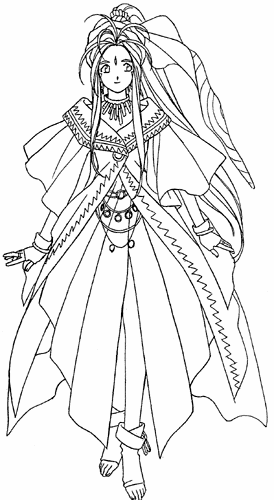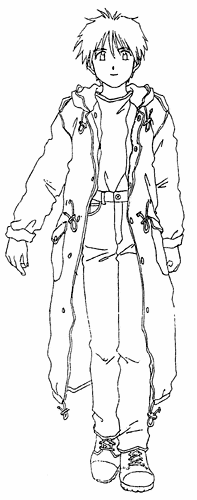One problem always faced is how to translate the names of
japanese people, because Japanese has fewer sounds than english. It is often impossible to
translate a name into English and have someone pronounce it right the first time, so
several systems have been developed to help people say them right. The system used by AnimEigo
to romanize the names (change them into English) has been borrowed from several of the
best ones, and I personally feel it is easy to follow and understand. It's not perfect but
it is basic enough to help anyone out.
Japanese
syllables consist of consonant-vowel combinations (except for "n" at the end of
some syllables). This is why the early Japanese pronounciation of "Verdandi"
(See Background Info) becomes "Ve-ru-dan-di"
in Japanese. Each syllable takes about the same amount of time to pronounce and is almost
always pronounced the same way, unlike in English, where each letter can have several
different pronounciations ( the old joke being that Ghoti is prounced Fish - enouGH,
wOmen, and ficTIon). |
 |
 |
There are five vowels, romanized as "a",
"e", "i", "o", and "u". They are pronounced
roughly as follows: "a" as in father, "e" as
in edward, "i" as in beat,
"u" as in book, and "o" as in goal.
It is easier to picture this by visualizing an "h" after them, although this is
not always accurate.
Just by
knowing the basic sounds (with some practice) you are on the way to making a fairly good
pronounciation of the words. There are some exceptions; Japanese consonants are in general
not as long as English ones, the sounds are similar, and sometimes are turned into double
consonants ("st" or "ch") to aid the proper pronounciation.
The
famous Japanese "r" is actually midway between the English "r" and
"l", and the Japanese have trouble telling the difference between the two (thus
the infamous "flied lice"). In almost all cases, AnimEigo used an "r"
to represent the sound, unless the owner of the name has expressed a preference.
The
only consonant that stands by itself is "n", which has several different but
similar sounds based on the context in which it appears. It is translated as either
"n" or "m", whichever is more appropriate.
Another
important thing is that Japanese often make use of long vowel sounds; double-length
syllables. These are usually represented by a double vowel, although occasionally
"oo" is represented as "ou" because it looks better. When you see a
long vowel like that, just let the sound of the vowel hang for a little longer than you
think you should and you should get it right. Japanese people don't expect you to get long
vowel sounds right, so your effort will be noticed.
Finally,
after all this, "Fujishima Kousuke" is pronouced "Fuh-jee-shee-mah
Kooh-sue-keh."
You can
test this system out by singing along with the songs on the anime videos. If you don't
have the lyrics, english and japanese translations are availabe here. |



